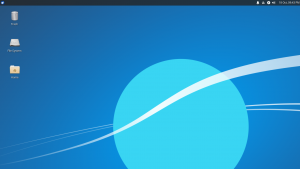Xubuntu
Xubuntu is a free Linux operating system that is easy to install. It has an interface that is similar to Windows and so is easy to learn for Windows users. It is a lightweight version of the Ubuntu operating system and makes a good Windows replacement.
Being Linux-based, Xubuntu has very few issues with malware or spyware and is very stable. It is free software, issued under free licenses.
Xubuntu comes with the Firefox web browser, LibreOffice word processor and spreadsheet, a text editor and many other applications most users need. It also has about 30,000 additional free software applications available at no charge, that can be installed using the included Gnome Software application.
If your computer has a DVD drive you can pick up a Xubuntu DVD at the NCF office or download the ISO file from Xubuntu.org and burn it to a DVD yourself with an ISO writer. If your computer does not have an optical drive, you can install it from a USB drive, as described below. You can try Xubuntu out as a "live session" before you install it. You can install it in place of Windows or along side it, choosing which system to use on reboot.
It is a good idea before replacing Windows to ensure that you will be able to open and edit your existing documents on your new operating system. Most commons formats, like .doc, .docx, xls, ppt, .pps, .txt, .pdf, etc are no problem. You can try this on a "live session", or, if you are unsure, you can ask on the NCF Free Software Discussion Group. That group is also a good place to ask general questions about Xubuntu and Linux.
Minimum System Requirements
- 1 GB of RAM
- 7.5 GB of free disk space
- A processor that supports PAE
Installing Xubuntu
This explains how to install Xubuntu from Windows:
Xubuntu installation (if you have a DVD already)
- Complete a back-up of all documents and bookmarks
- Boot to a "live session" ("Try Xubuntu without installing") to ensure that Xubuntu will work properly with your hardware (many computers require entering the computer set-up on boot to allow it to boot to a DVD before the hard drive)
- Install Xubuntu from live session desktop "Install" or from boot screen "Install Xubuntu"
- Re-install documents from back-ups
- Re-install bookmarks in Firefox Ctrl-Shift-O → Import and back up
- Set up and test printer, if you have one
- Add desired applications from System Tools → Gnome Software application
Xubuntu installation (with your own DVD)
- Download the Xubuntu ISO file from https://xubuntu.org/download/
- Download the ISO recorder at http://isorecorder.alexfeinman.com/#/
- Verify the integrity of the downloaded Xubuntu ISO file by comparing its SHA256 sum to the one for your release on http://cdimage.ubuntu.com/xubuntu/releases/. This ensures that the ISO has not been compromised or corrupted.
- Launch the ISO recorder and use it to burn the ISO image to your DVD
- Complete a back-up of all documents and bookmarks
- Boot to the DVD, and at the two icon screen, hit any key to take you to the menu. Test it using the DVD's built-in "Check disk for defects" to ensure the DVD was burnt correctly (many computers require entering the computer set-up on boot to allow it to boot to a DVD before the hard drive)
- Boot to a "live session" ("Try Xubuntu without installing") to ensure that Xubuntu will work properly with your hardware
- Install Xubuntu from live session desktop "Install" or from boot screen "Install Xubuntu"
- Re-install documents from back-ups
- Re-install bookmarks in Firefox Ctrl-Shift-O → Import and back up
- Set up and test printer, if you have one
- Add desired applications from System Tools → Gnome Software application
Xubuntu installation (with your own USB)
- Download the Xubuntu ISO file from https://xubuntu.org/download/
- Download the UNetBootIn ISO USB recorder at http://unetbootin.github.io/
- Verify the integrity of the downloaded Xubuntu ISO file by comparing its SHA256 sum to the one for your release on http://cdimage.ubuntu.com/xubuntu/releases/. This ensures that the ISO has not been compromised or corrupted.
- Launch UNetBootIn ISO USB recorder and use it to unpack the ISO image onto your USB
- Complete a back-up of all documents and bookmarks
- Boot to the USB, and at the two icon screen, hit any key to take you to the menu. Test it using the USB image's built-in "Check disk for defects" to ensure the DVD was burnt correctly (many computers require entering the computer set-up on boot to allow it to boot to a USB before the hard drive)
- Boot to a "live session" ("Try Xubuntu without installing") to ensure that Xubuntu will work properly with your hardware
- Install Xubuntu from live session desktop "Install" or from boot screen "Install Xubuntu"
- Re-install documents from back-ups
- Re-install bookmarks in Firefox Ctrl-Shift-O → Import and back up
- Set up and test printer, if you have one
- Add desired applications from System Tools → Gnome Software application
See also
External links
- Xubuntu Official website
- Xubuntu on Wikipedia
- Ask Ubuntu help forum help with Xubuntu
- Ubuntu Forums help with Xubuntu
- NCF Free Software Discussion Group


